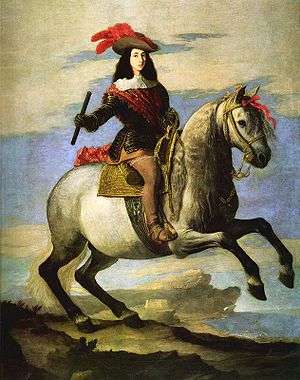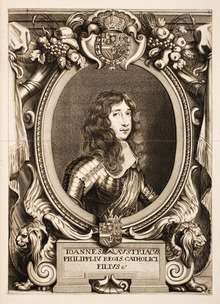John of Austria the Younger
| John of Austria the Younger | |
|---|---|
 | |
| Born | 7 April 1629 |
| Died | 17 September 1679 (aged 50) |
| Parent(s) |
Philip IV of Spain María Calderón |
.svg.png)
John of Austria (the Younger) or John Joseph of Austria (Spanish: Don Juan José de Austria) (7 April 1629 – 17 September 1679) was a Spanish general and political figure. He was the only bastard son of Philip IV of Spain to be acknowledged by the King and trained for military command and political administration. Don John advanced the causes of the Spanish Crown militarily and diplomatically at Naples, Sicily, Catalonia, the Netherlands, Portugal, Dunkirk and other fronts, and remained a popular hero even as the fortunes of Imperial Spain began to decline. In 1677 in a palace coup he took control of the monarchy of his half-brother Charles II of Spain, but he proved far from the savior Spain had hoped he would be. He remained in power until his death in 1679.
His mother was María Calderón (La Calderona), a popular actress, who was forced into a convent shortly after his birth.[1] He was raised in León by a woman of modest circumstances who likely did not know his parentage, though he received "a careful education" at Ocaña (Toledo).[2][3] In 1642, the King recognized him officially as his son, and John began his life's career as a military representative of his father's interests.
Don John was sent in 1647 to Naples, then in the throes of the popular rising first led by Masaniello, with a naval squadron and a military force, to support the viceroy.[4] There he played a waiting game. While the Duke of Arcos inserted agents, Don John surrounded the seething city with his forces until the exhaustion of the insurgents and the follies of their French leader, Henry, duke of Guise allowed him to move in, crush the remains of the revolt and drive out the, by then, despised French.
He was next sent as viceroy to Sicily, whence he was recalled in 1651 to complete the pacification of Catalonia, which had been in revolt since 1640. The high handedness of the French, whom the Catalans had called in to help their revolt, had produced a reaction, and many switched their loyalties back to the Spanish King. By the time Don John assumed command, most of Catalonia had been recovered and he had not much more to do than to preside over the final siege of Barcelona and the convention which terminated the revolt in October 1652.[4]

On both occasions, he played the peacemaker, and this sympathetic part, combined with his own pleasant manners, an engaging personality, a handsome person with bright eyes and abundant raven-black hair - a complete contrast to his Habsburg relatives in court - made him a popular royal favorite. In 1656, he was sent to command in Flanders, then in revolt against his own sovereign. At the storming of the French camp at Battle of Valenciennes (1656) in 1656, Don Juan Jose displayed great personal courage at the head of a brilliantly executed cavalry charge that caught the French totally by surprise. When, however, he took a part in the leadership of the army at the battle of the Dunes, fought against the French under Turenne and the British forces sent by Cromwell, he was decisively defeated and failed to raise the siege of Dunkirk, in spite of the efforts of Condé, whose invaluable advice he neglected, and the stubborn fight put up by his own troops.[4]

During 1661 and 1662, he fought against the Portuguese in Extremadura. The Spanish troops were ill-supplied and irregularly paid and in a rugged, hostile country. Morale was poor and they were untrustworthy but they were superior in numbers and some successes were gained. If Don John had not suffered from the indolence which Clarendon considered his chief defect, the Portuguese might have been hard pressed. John's forces overran the greater part of southern Portugal, but in 1663, with the Portuguese forces reinforced by a body of English troops, and put under the command of the Huguenot Schomberg, Don John was completely beaten at Estremoz.[4]
Even so, he might not have lost the confidence of his father, if Queen Mariana, mother of the sickly Infante Charles, the only surviving legitimate son of the king, had not regarded him with distrust and dislike. Don John was removed from command and sent to his command at Consuegra. After the death of Philip IV. in 1665 Don John became the recognized leader of the opposition to the government of Philip's widow, the regent. She and her favorite, the German Jesuit Juan Everardo Nithard, seized and put to death one of his most trusted servants, Don Jose Malladas.[4]
Don John, in return, put himself at the head of a rising of Aragon and Catalonia, which led to the expulsion of Nithard on 25 February 1669. Don John was, however, forced to content himself with the viceroyalty of Aragon. In 1677, the queen mother aroused universal opposition by her shameless favor for Fernando de Valenzuela. Don John was able to drive her from court, and establish himself as prime minister. Great hopes were entertained for his administration, but it proved disappointing and short; Don John died, perhaps by poison,[5] on 17 September 1679.[4]
His name featured prominently in the Popish Plot fabricated by Titus Oates in 1678. Oates unwisely claimed to have met Don John in Madrid; when questioned closely by Charles II, who had met Don John in 1656, it became clear that Oates had no idea what he looked like, confirming the King's suspicion that the Plot was an invention.
References
- Dunlop, John C. 1834. Memoirs of Spain during the Reigns of Philip IV. and Charles II. from 1621 to 1700, vol. II. Thomas Clark: Edinburgh.
Notes
- ↑ Madame D'Aulnoy (1930). Travels Into Spain. Oxford: OxfordCurzon, reprint of 1691.
- ↑ Rodriguez, Ignacio Ruiz. 2007. Don Juan Jose de Austria en la monarquia hispanica: Entre La Politica, El Poder Y La Intriga. Madrid: Dykinson.
- ↑ An example of how el conde-duque Olivares managed to keep the king's illegitimate children secret is recounted in the chapter titled "A Sprig of the House of Austria," in Hume's collection of essays The Year After the Armada (1896).
- 1 2 3 4 5 6
 One or more of the preceding sentences incorporates text from a publication now in the public domain: Chisholm, Hugh, ed. (1911). "John, Don". Encyclopædia Britannica. 15 (11th ed.). Cambridge University Press. p. 447.
One or more of the preceding sentences incorporates text from a publication now in the public domain: Chisholm, Hugh, ed. (1911). "John, Don". Encyclopædia Britannica. 15 (11th ed.). Cambridge University Press. p. 447. - ↑ Hume, Martin Andrew Sharp. 1896. The year after the Armada: and other historical studies. New York: Macmillan, p. 292.
| Preceded by Archduke Leopold Wilhelm of Austria |
Governor-General of the Spanish Netherlands 1656–1659 |
Succeeded by Luis de Benavides Carrillo, Marquis of Caracena |